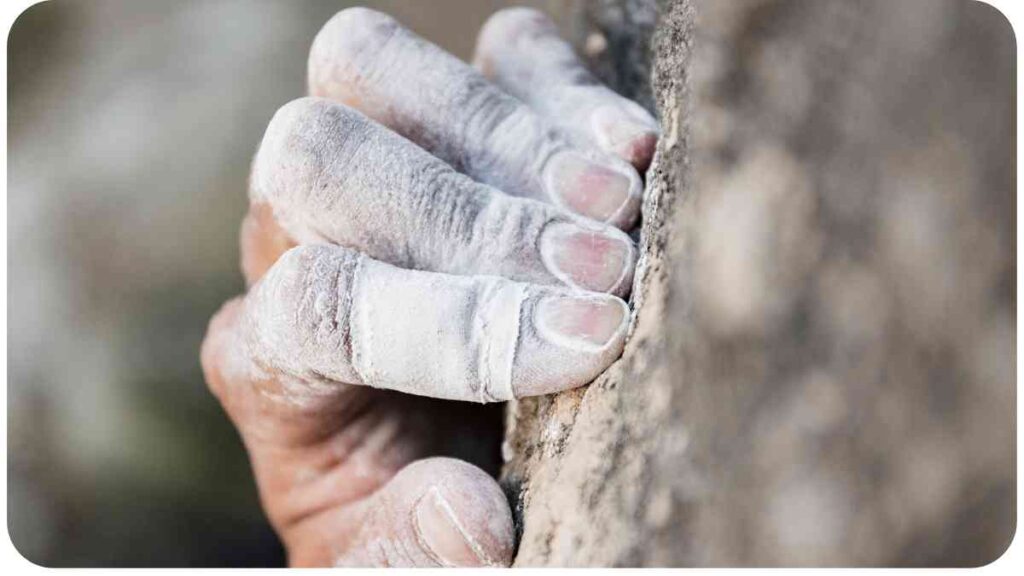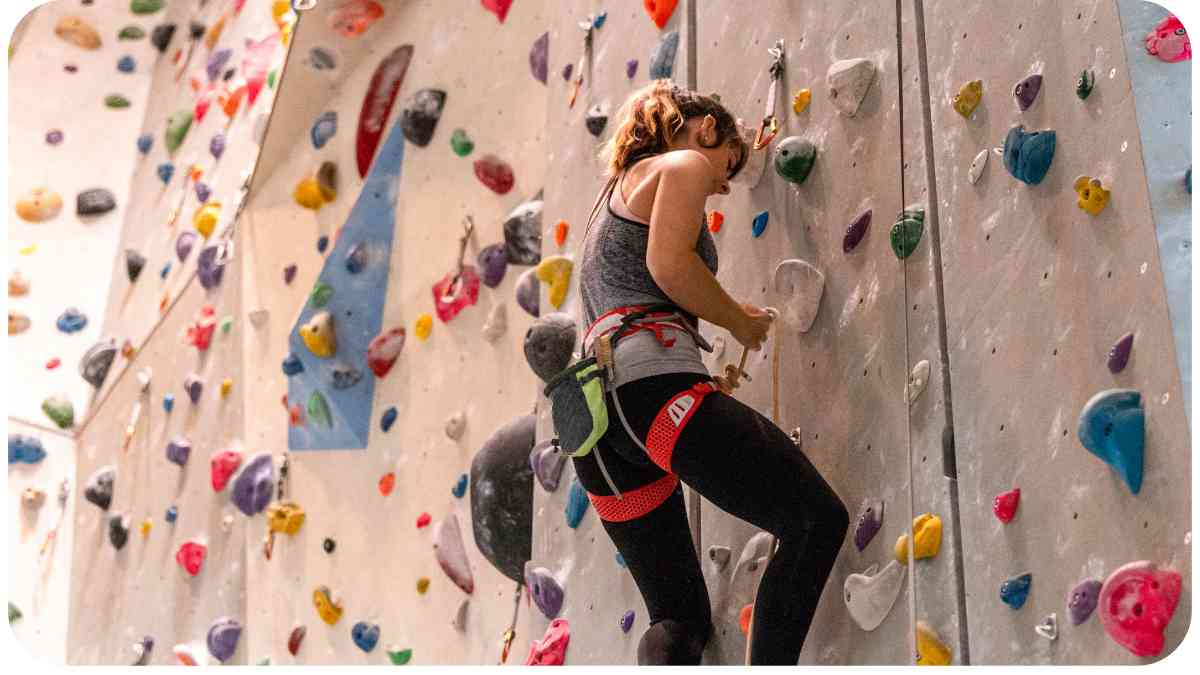Welcome climbers, to a comprehensive guide on grappling with one of the most frustrating aspects of climbing: inconsistent climbing chalk. As an experienced climber myself, I understand the importance of a reliable grip while scaling rock faces or tackling indoor walls.
In this article, we will delve into the factors influencing chalk quality, common issues climbers face with inconsistent chalk, and most importantly, offer you practical solutions to achieve a better grip.
| Takeaways |
|---|
| Factors influencing chalk consistency |
| Importance of proper chalk storage |
| Benefits of using chalk balls or socks |
| Mixing different chalk types for optimal grip |
| Personalizing chalk blends for your climbing style |
| Reputable brands for reliable chalk |
| Tips for optimal chalk usage and maintenance |
| Consideration of alternatives like liquid chalk and climbing tape |
| Importance of chalk hygiene for clean and effective grip |
| Exploring further resources for in-depth knowledge |
2. The Importance of Climbing Chalk
Before we explore the challenges of inconsistent climbing chalk, let’s highlight the significance of chalk for climbers. Climbing chalk, typically made from magnesium carbonate, plays a vital role in absorbing moisture from our hands, thereby improving friction and grip on holds.
This extra friction can make a world of difference when it comes to tackling complex climbs or making precise movements. However, not all chalk is created equal, and poor quality or inconsistent chalk can significantly hinder your performance.
Uncover hidden gems in ice climbing with underrated spots. Discover uncharted terrains and elevate your climbing experience.
3. Understanding Inconsistent Climbing Chalk

3.1 Factors Influencing Chalk Quality Inconsistent climbing chalk can result from various factors including manufacturing processes, environmental conditions during storage and transportation, and even variations in raw materials. These factors can impact the texture, moisture content, and overall effectiveness of the chalk, leading to frustrating grip problems for climbers.
3.2 Common Issues with Inconsistent Chalk When grappling with inconsistent chalk, climbers may encounter a range of issues such as clumpy or chunky texture, excessive moisture content, or overly dry and powdery chalk. Each of these problems can affect your grip differently, making it difficult to trust your chalk when it matters most.
4. Solutions for Ensuring Chalk Consistency
While inconsistent climbing chalk may seem like an insurmountable challenge, there are several strategies you can employ to enhance chalk consistency and ensure a reliable grip. Let’s explore these solutions in detail.
4.1 Choosing the Right Chalk Brand Table 1 provides a comparison of popular chalk brands, highlighting their texture, moisture content, and user feedback. By selecting a reputable brand with consistent quality, you can increase the likelihood of obtaining reliable chalk for your climbing adventures.
4.2 Tips for Proper Chalk Storage Proper chalk storage is crucial for maintaining consistency and longevity. Avoid storing your chalk in areas prone to moisture, such as damp basements or near water sources. Instead, use airtight containers to minimize exposure to air and humidity. By protecting your chalk from external elements, you can ensure it remains in optimal condition for reliable grip.
4.3 Using Chalk Balls or Socks To further enhance chalk consistency, consider utilizing chalk balls or socks. These porous containers enclose your chalk, minimizing clumping and preventing excessive chalk distribution during use. With chalk balls or socks, you can achieve a more even and controlled application of chalk, ensuring a consistent grip.
Ascend with swiftness and precision using speed climbing tips. Enhance your climbing prowess with expert advice for a faster, more efficient climb.
4.4 Mixing Different Chalk Types Experimenting with different chalk types can offer a solution to inconsistent chalk. Table 3 outlines various chalk types along with their characteristics, allowing you to mix and blend chalks to achieve a texture and moisture content that works best for you.
4.5 Personalized Chalk Blends By personalizing your chalk blend, you can create a customized mix that suits your unique needs. This approach involves mixing different chalk types, adjusting the ratio of fine and chunky textures, and adding moisture-absorbing agents like rice or silica packets. Through trial and error, you can create a personalized chalk blend that provides the ideal consistency and grip for your climbing style.
Table 3: Chalk Types and Their Characteristics
| Chalk Type | Texture | Moisture Content | Suitable for |
| Fine Chalk | Fine | Low | Precision movements |
| Chunky Chalk | Chunky | High | Longer climbs, sweaty hands |
| Block Chalk | Solid blocks | Low-Medium | Gym and indoor climbing |
| Eco-friendly Chalk | Fine | Low | Environmentally conscious climbers |
5. Proven Brands for Reliable Chalk
Choosing a reputable brand can greatly increase the chances of obtaining consistently reliable chalk. Here are a few brands that are well-regarded within the climbing community:
- Brand A: Known for its fine texture and low moisture content, this brand has received positive feedback from climbers who value a precise grip.
- Brand B: With a chunky texture and higher moisture content, this brand has received mixed reviews. It may work well for climbers tackling longer routes or with naturally sweaty hands.
- Brand C: This brand offers a powdery texture and medium moisture content. Some climbers have reported negative experiences with this brand, so it’s worth considering alternatives.
Ensure you explore different brands, read user reviews, and consider your personal preferences to find the chalk brand that suits you best.
Navigate bouldering pitfalls effortlessly by learning common mistakes. Elevate your bouldering skills with insights on what to avoid and how to conquer challenges.
6. Expert Tips and Techniques for Optimal Chalk Usage
6.1 Chalk Grades and Their Uses Different grades of climbing chalk are available, each catering to specific climbing scenarios. Table 2 provides an overview of chalk grades and their applications.
Table 2: Chalk Grades and Their Uses
| Chalk Grade | Uses |
| Super Fine | Bouldering, intricate hand movements |
| Fine | Sport climbing, technical routes |
| Medium | Longer climbs, endurance activities |
| Chunky | Sweaty hands, high-friction situations |
By understanding the characteristics of each chalk grade and matching it to your climbing style and conditions, you can optimize your grip.
6.2 Chalk Types and Their Characteristics Refer to Table 3 earlier in this article for an overview of different chalk types and their associated textures and moisture contents. Experimenting with various chalk types can help you find the perfect balance that provides consistent grip.
Embark on a rock climbing journey exploring routes for every skill level. Find exhilarating paths suited to your expertise and elevate your climbing adventures.
7. Maintaining Climbing Chalk Hygiene

7.1 Avoiding Cross-Contamination in Chalk Bins Shared chalk bins at climbing gyms can become breeding grounds for bacteria and germs. To maintain hygiene, avoid touching the chalk with dirty hands or sharing your chalk with others. Consider using personal chalk bags or refillable chalk balls to reduce the risk of cross-contamination.
7.2 Cleaning Your Hands before Chalking Up Keeping your hands clean before applying chalk can significantly improve grip consistency. Wash your hands thoroughly, removing any dirt or oils. Dry them completely before proceeding with your chalk application.
7.3 Proper Chalk Brush Maintenance Chalk brushes are essential tools for cleaning holds and removing excess chalk. To maintain their effectiveness, make sure to clean your chalk brush regularly by rinsing it with water and mild soap. Allow it to air dry before storing it in a clean and dry container.
8. Overcoming Other Grip Challenges
8.1 Liquid Chalk as an Alternative If you constantly struggle with inconsistent chalk, consider using liquid chalk as an alternative. Liquid chalk offers a more consistent texture and better adherence. Apply it to your hands and let it dry, creating a chalk layer that provides a reliable grip throughout your climb.
8.2 Climbing Tape for Added Support In addition to chalk, climbing tape can provide added support and grip on challenging holds. Wrap tape around your fingers or use it strategically to enhance grip strength and protect vulnerable areas. Proper taping techniques can make a noticeable difference during your climbs.
Conquer altitude challenges with knowledge on altitude sickness remedies. Understand the causes, symptoms, and effective remedies for a safer and more enjoyable climbing experience.
9. Conclusion
In conclusion, grappling with inconsistent climbing chalk can be a frustrating experience. However, with the right knowledge and solutions, you can significantly improve your grip and overall climbing performance. By selecting reputable chalk brands, employing proper storage techniques, and experimenting with personalized chalk blends, you can enhance chalk consistency and achieve a reliable grip.
Additionally, maintaining chalk hygiene, exploring different chalk grades and types, and considering alternatives like liquid chalk and climbing tape can further enhance your climbing experience. Remember, a solid grip is crucial for success on the rock, so don’t underestimate the importance of consistent and reliable climbing chalk.
Further Reading
For additional information on climbing chalk and enhancing your grip, consider exploring the following resources:
- Liquid Grip Canada – Climbing Hand Chalk: Liquid Grip Canada offers a wide range of climbing hand chalk products. Visit their website to find out more about their offerings and how their products can improve your grip.
- PubMed – Climbing Chalk: A Scientific Exploration: This scientific study delves into the characteristics and effects of climbing chalk on grip performance. It provides valuable insights into the science behind chalk usage in climbing.
- Liquid Chalk Shop Blog – Liquid Chalk for Rock Climbing: Liquid Chalk Shop’s blog post explores the benefits and applications of liquid chalk specifically for rock climbing. Discover how liquid chalk can enhance your grip and overall climbing experience.
FAQs
What are the different types of chalk available for climbing?
There are various types of chalk available for climbing, including fine chalk, chunky chalk, block chalk, and eco-friendly chalk. Each type has different textures and moisture contents, catering to different climbing scenarios and personal preferences.
How can I store my climbing chalk to maintain its consistency?
To maintain chalk consistency, store it in airtight containers in dry areas, away from moisture. Avoid storing chalk in damp basements or near water sources, as exposure to humidity can affect its quality.
Can I mix different types of chalk to achieve a desired consistency?
Yes, mixing different types of chalk can help you achieve a personalized blend that suits your grip preferences. Experiment with different ratios and combinations to find the consistency that works best for you.
Is liquid chalk a good alternative to traditional chalk?
Liquid chalk can be a reliable alternative to traditional chalk, as it offers a more consistent texture and better adherence. It can provide a long-lasting grip and is particularly useful in humid environments or for climbers with naturally sweaty hands.
How can I maintain chalk hygiene?
To maintain chalk hygiene, avoid sharing your chalk with others and consider using personal chalk bags or refillable chalk balls. Also, ensure that your hands are clean and dry before applying chalk to prevent cross-contamination.

Welcome to my blog! I’m Hellen James, and I’m incredibly passionate about rock climbing, bouldering, ice climbing, and mountaineering. Join me as I embark on thrilling adventures, conquer vertical challenges, and share my experiences and insights with fellow outdoor enthusiasts.


